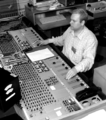User interface
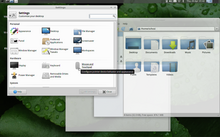
In theindustrial designfield ofhuman–computer interaction,auser interface(UI) is the space where interactions between humans and machines occur. The goal of this interaction is to allow effective operation and control of the machine from the human end, while the machine simultaneously feeds back information that aids the operators'decision-makingprocess. Examples of this broad concept of user interfaces include the interactive aspects of computeroperating systems,handtools,heavy machineryoperator controls andprocesscontrols. The design considerations applicable when creating user interfaces are related to, or involve such disciplines as,ergonomicsandpsychology.
Generally, the goal ofuser interface designis to produce a user interface that makes it easy, efficient, and enjoyable (user-friendly) to operate a machine in the way which produces the desired result (i.e. maximumusability). This generally means that the operator needs to provide minimal input to achieve the desired output, and also that the machine minimizes undesired outputs to the user.
User interfaces are composed of one or more layers, including ahuman–machine interface(HMI) that typically interfaces machines with physicalinput hardware(such as keyboards, mice, or game pads) and output hardware (such ascomputer monitors,speakers, andprinters). A device that implements an HMI is called ahuman interface device(HID). User interfaces that dispense with the physical movement of body parts as an intermediary step between the brain and the machine use no input or output devices except electrodes alone; they are calledbrain–computer interfaces(BCIs) orbrain–machine interfaces(BMIs).
Other terms for human–machine interfaces areman–machine interface(MMI) and, when the machine in question is a computer,human–computer interface.Additional UI layers may interact with one or more human senses, including: tactile UI (touch), visual UI (sight), auditory UI (sound), olfactory UI (smell), equilibria UI (balance), and gustatory UI (taste).
Composite user interfaces(CUIs) are UIs that interact with two or more senses. The most common CUI is agraphical user interface(GUI), which is composed of a tactile UI and a visual UI capable of displayinggraphics.When sound is added to a GUI, it becomes amultimedia user interface(MUI). There are three broad categories of CUI:standard,virtualandaugmented.Standard CUI use standard human interface devices like keyboards, mice, and computer monitors. When the CUI blocks out the real world to create avirtual reality,the CUI is virtual and uses avirtual reality interface.When the CUI does not block out the real world and createsaugmented reality,the CUI is augmented and uses anaugmented reality interface.When a UI interacts with all human senses, it is called a qualia interface, named after the theory ofqualia.[citation needed]CUI may also be classified by how many senses they interact with as either an X-sense virtual reality interface or X-sense augmented reality interface, where X is the number of senses interfaced with. For example, aSmell-O-Visionis a 3-sense (3S) Standard CUI with visual display, sound and smells; whenvirtual reality interfacesinterface with smells and touch it is said to be a 4-sense (4S) virtual reality interface; and whenaugmented reality interfacesinterface with smells and touch it is said to be a 4-sense (4S) augmented reality interface.
Overview
[edit]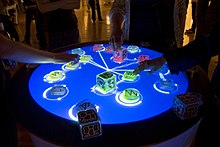
The user interface orhuman–machine interfaceis the part of the machine that handles the human–machine interaction. Membrane switches, rubber keypads and touchscreens are examples of the physical part of the Human Machine Interface which we can see and touch.[1]
In complex systems, the human–machine interface is typically computerized. The termhuman–computer interfacerefers to this kind of system. In the context of computing, the term typically extends as well to the software dedicated to control the physical elements used forhuman–computer interaction.
The engineering of human–machine interfaces is enhanced by consideringergonomics(human factors). The corresponding disciplines arehuman factors engineering(HFE) andusability engineering(UE) which is part ofsystems engineering.
Tools used for incorporating human factors in the interface design are developed based on knowledge ofcomputer science,such ascomputer graphics,operating systems,programming languages.Nowadays, we use the expressiongraphical user interfacefor human–machine interface on computers, as nearly all of them are now using graphics.[citation needed]
Multimodal interfacesallow users to interact using more than onemodalityof user input.[2]
Terminology
[edit]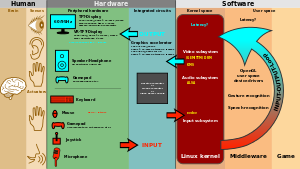
There is a difference between a user interface and an operator interface or a human–machine interface (HMI).
- The term "user interface" is often used in the context of (personal) computer systems andelectronic devices.
- Where a network of equipment or computers are interlinked through an MES (Manufacturing Execution System)-or Host to display information.
- A human–machine interface (HMI) is typically local to one machine or piece of equipment, and is the interface method between the human and the equipment/machine. An operator interface is the interface method by which multiple pieces of equipment, linked by a host control system, are accessed or controlled.[clarification needed]
- The system may expose several user interfaces to serve different kinds of users. For example, acomputerized library databasemight provide two user interfaces, one for library patrons (limited set of functions, optimized for ease of use) and the other for library personnel (wide set of functions, optimized for efficiency).[3]
- The user interface of amechanicalsystem, a vehicle or anindustrialinstallation is sometimes referred to as the human–machine interface (HMI).[4]HMI is a modification of the original term MMI (man–machine interface).[5]In practice, the abbreviation MMI is still frequently used[5]although some may claim that MMI stands for something different now.[citation needed]Another abbreviation is HCI, but is more commonly used forhuman–computer interaction.[5]Other terms used are operator interface console (OIC) and operator interface terminal (OIT).[6]However it is abbreviated, the terms refer to the 'layer' that separates a human that is operating a machine from the machine itself.[5]Without a clean and usable interface, humans would not be able to interact with information systems.
Inscience fiction,HMI is sometimes used to refer to what is better described as adirect neural interface.However, this latter usage is seeing increasing application in the real-life use of (medical)prostheses—the artificial extension that replaces a missing body part (e.g.,cochlear implants).[7][8]
In some circumstances, computers might observe the user and react according to their actions without specific commands. A means oftracking parts of the bodyis required, and sensors noting the position of the head,direction of gazeand so on have been used experimentally. This is particularly relevant toimmersive interfaces.[9][10]
History
[edit]The history of user interfaces can be divided into the following phases according to the dominant type of user interface:
1945–1968: Batch interface
[edit]
In the batch era, computing power was extremely scarce and expensive. User interfaces were rudimentary. Users had to accommodate computers rather than the other way around; user interfaces were considered overhead, and software was designed to keep the processor at maximum utilization with as little overhead as possible.
The input side of the user interfaces for batch machines was mainlypunched cardsor equivalent media likepaper tape.The output side addedline printersto these media. With the limited exception of the systemoperator's console,human beings did not interact with batch machines in real time at all.
Submitting a job to a batch machine involved first preparing a deck of punched cards that described a program and its dataset. The program cards were not punched on the computer itself but onkeypunches,specialized, typewriter-like machines that were notoriously bulky, unforgiving, and prone to mechanical failure. The software interface was similarly unforgiving, with very strict syntaxes designed to be parsed by the smallest possible compilers and interpreters.

Once the cards were punched, one would drop them in a job queue and wait. Eventually, operators would feed the deck to the computer, perhaps mountingmagnetic tapesto supply another dataset or helper software. The job would generate a printout, containing final results or an abort notice with an attached error log. Successful runs might also write a result on magnetic tape or generate some data cards to be used in a later computation.
Theturnaround timefor a single job often spanned entire days. If one was very lucky, it might be hours; there was no real-time response. But there were worse fates than the card queue; some computers required an even more tedious and error-prone process of toggling in programs in binary code using console switches. The very earliest machines had to be partly rewired to incorporate program logic into themselves, using devices known asplugboards.
Early batch systems gave the currently running job the entire computer; program decks and tapes had to include what we would now think of asoperating systemcode to talk to I/O devices and do whatever other housekeeping was needed. Midway through the batch period, after 1957, various groups began to experiment with so-called "load-and-go"systems. These used amonitor programwhich was always resident on the computer. Programs could call the monitor for services. Another function of the monitor was to do better error checking on submitted jobs, catching errors earlier and more intelligently and generating more useful feedback to the users. Thus, monitors represented the first step towards both operating systems and explicitly designed user interfaces.
1969–present: Command-line user interface
[edit]
Command-line interfaces(CLIs) evolved from batch monitors connected to the system console. Their interaction model was a series of request-response transactions, with requests expressed as textual commands in a specialized vocabulary. Latency was far lower than for batch systems, dropping from days or hours to seconds. Accordingly, command-line systems allowed the user to change their mind about later stages of the transaction in response to real-time or near-real-time feedback on earlier results. Software could be exploratory and interactive in ways not possible before. But these interfaces still placed a relatively heavymnemonicload on the user, requiring a serious investment of effort and learning time to master.[11]
The earliest command-line systems combinedteleprinterswith computers, adapting a mature technology that had proven effective for mediating the transfer of information over wires between human beings. Teleprinters had originally been invented as devices for automatic telegraph transmission and reception; they had a history going back to 1902 and had already become well-established in newsrooms and elsewhere by 1920. In reusing them, economy was certainly a consideration, but psychology and therule of least surprisemattered as well; teleprinters provided a point of interface with the system that was familiar to many engineers and users.

The widespread adoption of video-display terminals (VDTs) in the mid-1970s ushered in the second phase of command-line systems. These cut latency further, because characters could be thrown on the phosphor dots of a screen more quickly than a printer head or carriage can move. They helped quell conservative resistance to interactive programming by cutting ink and paper consumables out of the cost picture, and were to the first TV generation of the late 1950s and 60s even more iconic and comfortable than teleprinters had been to the computer pioneers of the 1940s.
Just as importantly, the existence of an accessible screen—a two-dimensional display of text that could be rapidly and reversibly modified—made it economical for software designers to deploy interfaces that could be described as visual rather than textual. The pioneering applications of this kind were computer games and text editors; close descendants of some of the earliest specimens, such asrogue(6), andvi(1), are still a live part ofUnixtradition.
1985: SAA user interface or text-based user interface
[edit]In 1985, with the beginning ofMicrosoft Windowsand othergraphical user interfaces,IBM created what is called theSystems Application Architecture(SAA) standard which include theCommon User Access(CUA) derivative. CUA successfully created what we know and use today in Windows, and most of the more recentDOSor Windows Console Applications will use that standard as well.
This defined that a pulldown menu system should be at the top of the screen, status bar at the bottom, shortcut keys should stay the same for all common functionality (F2 to Open for example would work in all applications that followed the SAA standard). This greatly helped the speed at which users could learn an application so it caught on quick and became an industry standard.[12]
1968–present: Graphical user interface
[edit]

- 1968 –Douglas EngelbartdemonstratedNLS,a system which uses amouse,pointers,hypertext,and multiplewindows.[13]
- 1970 – Researchers atXerox Palo Alto Research Center(many fromSRI) developWIMPparadigm (Windows, Icons, Menus, Pointers)[13]
- 1973 –Xerox Alto:commercial failure due to expense, poor user interface, and lack of programs[13]
- 1979 –Steve Jobsand otherAppleengineers visit Xerox PARC. ThoughPirates of Silicon Valleydramatizes the events, Apple had already been working on developing a GUI, such as the Macintosh and Lisa projects, before the visit.[14][15]
- 1981 –Xerox Star:focus onWYSIWYG.Commercial failure (25K sold) due to cost ($16K each), performance (minutes to save a file, couple of hours to recover from crash), and poor marketing
- 1982 –Rob Pikeand others atBell LabsdesignedBlit,which was released in 1984 by AT&T andTeletypeas DMD 5620 terminal.
- 1984 – AppleMacintoshpopularizes theGUI.Super Bowl commercialshown twice, was the most expensive commercial ever made at that time
- 1984 –MIT'sX Window System:hardware-independent platform and networking protocol for developing GUIs on UNIX-like systems
- 1985 –Windows 1.0– provided GUI interface to MS-DOS. No overlapping windows (tiled instead).
- 1985 – Microsoft and IBM start work on OS/2 meant to eventually replace MS-DOS and Windows
- 1986 – Apple threatens to sueDigital Researchbecause their GUI desktop looked too much like Apple's Mac.
- 1987 –Windows 2.0– Overlapping and resizable windows, keyboard and mouse enhancements
- 1987 – Macintosh II: first full-color Mac
- 1988 –OS/21.10 Standard Edition (SE) has GUI written by Microsoft, looks a lot like Windows 2
Interface design
[edit]Primary methods used in the interface design include prototyping and simulation.
Typical human–machine interface design consists of the following stages: interaction specification, interface software specification and prototyping:
- Common practices for interaction specification includeuser-centered design,persona,activity-oriented design, scenario-based design, and resiliency design.
- Common practices for interface software specification includeuse casesand constrain enforcement byinteraction protocols(intended to avoid use errors).
- Common practices for prototyping are based on libraries of interface elements (controls, decoration, etc.).
Principles of quality
[edit]In broad terms, interfaces generally regarded as user friendly, efficient, intuitive, etc. are typified by one or more particular qualities. For the purpose of example, a non-exhaustive list of such characteristics follows:
- Clarity: The interface avoids ambiguity by making everything clear through language, flow, hierarchy and metaphors for visual elements.
- Concision:[16]However ironically, the over-clarification of information—for instance, by labelling the majority, if not the entirety, of items displayed on-screen at once, and regardless of whether or not the user would in fact require a visual indicator of some kind in order to identify a given item—can, and, under most normal circumstances, most likely will lead to the obfuscation of whatever information.
- Familiarity:[17]Even if someone uses an interface for the first time, certain elements can still be familiar. Real-life metaphors can be used to communicate meaning.
- Responsiveness:[18]A good interface should not feel sluggish. This means that the interface should provide good feedback to the user about what's happening and whether the user's input is being successfully processed.
- Consistency:[19]Keeping your interface consistent across your application is important because it allows users to recognize usage patterns.
- Aesthetics:While you do not need to make an interface attractive for it to do its job, making something look good will make the time your users spend using your application more enjoyable; and happier users can only be a good thing.
- Efficiency:Time is money, and a great interface should make the user more productive through shortcuts and good design.
- Forgiveness:A good interface should not punish users for their mistakes but should instead provide the means to remedy them.
Principle of least astonishment
[edit]Theprinciple of least astonishment(POLA) is a general principle in the design of all kinds of interfaces. It is based on the idea that human beings can only pay full attention to one thing at one time,[20]leading to the conclusion that novelty should be minimized.
Principle of habit formation
[edit]If an interface is used persistently, the user will unavoidably develophabitsfor using the interface. The designer's role can thus be characterized as ensuring the user forms good habits. If the designer is experienced with other interfaces, they will similarly develop habits, and often make unconscious assumptions regarding how the user will interact with the interface.[20][21]
A model of design criteria: User Experience Honeycomb
[edit]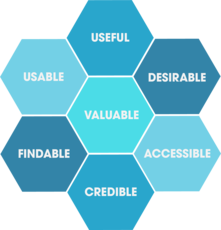
Peter Morville ofGoogledesigned the User Experience Honeycomb framework in 2004 when leading operations in user interface design. The framework was created to guide user interface design. It would act as a guideline for many web development students for a decade.[23]
- Usable: Is the design of the system easy and simple to use? The application should feel familiar, and it should be easy to use.[23][22]
- Useful: Does the application fulfill a need? A business's product or service needs to be useful.[22]
- Desirable: Is the design of the application sleek and to the point? The aesthetics of the system should be attractive, and easy to translate.[22]
- Findable: Are users able to quickly find the information they are looking for? Information needs to be findable and simple to navigate. A user should never have to hunt for your product or information.[22]
- Accessible:Does the application support enlarged text without breaking the framework? An application should be accessible to those with disabilities.[22]
- Credible: Does the application exhibit trustworthy security and company details? An application should be transparent, secure, and honest.[22]
- Valuable: Does the end-user think it's valuable? If all 6 criteria are met, the end-user will find value and trust in the application.[22]
Types
[edit]
- Attentive user interfacesmanage the userattentiondeciding when to interrupt the user, the kind of warnings, and the level of detail of the messages presented to the user.
- Batch interfacesare non-interactive user interfaces, where the user specifies all the details of thebatch jobin advance tobatch processing,and receives the output when all the processing is done. The computer does not prompt for further input after the processing has started.
- Command line interfaces(CLIs) prompt the user to provide input by typing acommand stringwith the computer keyboard and respond by outputting text to the computer monitor. Used by programmers and system administrators, in engineering and scientific environments, and by technically advanced personal computer users.
- Conversational interfacesenable users to command the computer with plain text English (e.g., via text messages, or chatbots) or voice commands, instead of graphic elements. These interfaces often emulate human-to-human conversations.[24]
- Conversational interface agentsattempt to personify the computer interface in the form of an animated person, robot, or other character (such as Microsoft's Clippy the paperclip), and present interactions in a conversational form.
- Crossing-based interfacesare graphical user interfaces in which the primary task consists in crossing boundaries instead of pointing.
- Direct manipulation interfaceis a general class of user interfaces that allow users to manipulate objects presented to them, using actions that correspond to the physical world, at least loosely.
- Gesture interfacesare graphical user interfaces which accept input in a form of handgestures,ormouse gesturessketched with a computer mouse or astylus.
- Graphical user interfaces(GUI) accept input via devices such as a computer keyboard and mouse and provide articulatedgraphicaloutput on thecomputer monitor.[25]There are at least two different principles widely used in GUI design:Object-oriented user interfaces(OOUIs) andapplication-oriented interfaces.[26]
- Hardware interfacesare the physical, spatial interfaces found on products in the real world from toasters, to car dashboards, to airplane cockpits. They are generally a mixture of knobs, buttons, sliders, switches, and touchscreens.
- Holographic user interfacesprovide input to electronic or electro-mechanical devices by passing a finger through reproduced holographic images of what would otherwise be tactile controls of those devices, floating freely in the air, detected by a wave source and without tactile interaction.
- Intelligent user interfacesare human–machine interfaces that aim to improve the efficiency, effectiveness, and naturalness of human–machine interaction by representing, reasoning, and acting on models of the user, domain, task, discourse, and media (e.g., graphics, natural language, gesture).
- Motion trackinginterfacesmonitor the user's body motions and translate them into commands, currently being developed by Apple.[27]
- Multi-screen interfaces,employ multiple displays to provide a more flexible interaction. This is often employed in computer game interaction in both the commercial arcades and more recently the handheld markets.
- Natural-language interfacesare used for search engines and on webpages. User types in a question and waits for a response.
- Non-command user interfaces,which observe the user to infer their needs and intentions, without requiring that they formulate explicit commands.[28]
- Object-oriented user interfaces(OOUI)are based onobject-oriented programmingmetaphors, allowing users tomanipulatesimulated objects and their properties.
- Permission-driven user interfacesshow or conceal menu options or functions depending on the user's level of permissions. The system is intended to improve the user experience by removing items that are unavailable to the user. A user who sees functions that are unavailable for use may become frustrated. It also provides an enhancement to security by hiding functional items from unauthorized persons.
- Reflexive user interfaceswhere the users control and redefine the entire system via the user interface alone, for instance to change itscommand verbs.Typically, this is only possible with very rich graphic user interfaces.
- Search interfaceis how the search box of a site is displayed, as well as the visual representation of the search results.
- Tangible user interfaces,which place a greater emphasis on touch and physical environment or its element.
- Task-focused interfacesare user interfaces which address theinformation overloadproblem of thedesktop metaphorby making tasks, not files, the primary unit of interaction.
- Text-based user interfaces(TUIs) are user interfaces which interact via text. TUIs includecommand-line interfacesand text-basedWIMPenvironments.
- Touchscreensare displays that accept input by touch of fingers or astylus.Used in a growing amount ofmobile devicesand many types ofpoint of sale,industrial processes and machines, self-service machines, etc.
- Touch user interfaceare graphical user interfaces using atouchpador touchscreen display as a combined input and output device. They supplement or replace other forms of output withhapticfeedback methods. Used in computerizedsimulators,etc.
- Voice user interfaces,which accept input and provide output by generating voice prompts. The user input is made by pressing keys or buttons, or responding verbally to the interface.
- Web-based user interfacesorweb user interfaces(WUI) that accept input and provide output by generatingweb pagesviewed by the user using aweb browserprogram.
- Zero-input interfacesget inputs from a set of sensors instead of querying the user with input dialogs.[29]
- Zooming user interfacesare graphical user interfaces in which information objects are represented at different levels of scale and detail, and where the user can change the scale of the viewed area in order to show more detail.
Gallery
[edit]-
Historic HMI in the driver's cabin of aGermansteam locomotive
-
Modern HMI in the driver's cabin of aGermanIntercity-Expresshigh-speed train
-
The HMI of a toilette (in Japan)
-
HMI for audio mixing
-
HMI forvideo production
-
HMI of a machine for the sugar industry with pushbuttons
-
HMI for acomputer numerical control(CNC)
-
Slightly newer HMI for a CNC-machine
-
Emergency switch/panic switch
-
DMD 5620 terminal
See also
[edit]- Adaptive user interfaces
- Brain–computer interface
- Computer user satisfaction
- Direct voice input
- Distinguishable interfaces
- Ergonomicsandhuman factors– the study of designing objects to be better adapted to the shape of the human body
- Flat design
- History of the GUI
- Icon design
- Information architecture– organizing, naming, and labelling information structures
- Information visualization– the use of sensory representations of abstract data to reinforce cognition
- Interaction design
- Interaction technique
- Kinetic user interface
- Knowledge visualization– the use of visual representations to transfer knowledge
- Multiple frames interface
- Natural user interfaces
- Organic user interface
- Post-WIMP
- Tangible user interface
- Unified Code for Units of Measure
- Usability links
- User assistance
- User experience
- User experience design
- User interface design
- User interface specification
- Useware
- Virtual artifact
- Virtual user interface
References
[edit]- ^"Eurotherm Parker SSD Link Hardware L5392 | Automation Industrial".l5392.com.Retrieved11 January2024.
- ^Cohen, Philip R. (1992). "The role of natural language in a multimodal interface".Proceedings of the 5th annual ACM symposium on User interface software and technology - UIST '92.pp.143–149.doi:10.1145/142621.142641.ISBN0897915496.S2CID9010570.
- ^"The User Experience of Libraries: Serving The Common Good User Experience Magazine".uxpamagazine.org.7 May 2017.Retrieved23 March2022.
- ^Griffin, Ben; Baston, Laurel."Interfaces"(Presentation):5.Archivedfrom the original on 14 July 2014.Retrieved7 June2014.
The user interface of a mechanical system, a vehicle or an industrial installation is sometimes referred to as the human–machine interface (HMI).
{{cite journal}}:Cite journal requires|journal=(help) - ^abcd"User Interface Design and Ergonomics"(PDF).Course Cit 811.NATIONAL OPEN UNIVERSITY OF NIGERIA: SCHOOL OF SCIENCE AND TECHNOLOGY: 19.Archived(PDF)from the original on 14 July 2014.Retrieved7 June2014.
In practice, the abbreviation MMI is still frequently used although some may claim that MMI stands for something different now.
- ^"Introduction Section".Recent advances in business administration.[S.l.]: Wseas. 2010. p. 190.ISBN978-960-474-161-8.
Other terms used are operator interface console (OIC) and operator interface terminal (OIT)
- ^Cipriani, Christian; Segil, Jacob; Birdwell, Jay; Weir, Richard (2014)."Dexterous control of a prosthetic hand using fine-wire intramuscular electrodes in targeted extrinsic muscles".IEEE Transactions on Neural Systems and Rehabilitation Engineering.22(4):828–36.doi:10.1109/TNSRE.2014.2301234.ISSN1534-4320.PMC4501393.PMID24760929.
Neural co-activations are present that in turn generate significant EMG levels and hence unintended movements in the case of the present human machine interface (HMI).
- ^Citi, Luca (2009)."Development of a neural interface for the control of a robotic hand"(PDF).Scuola Superiore Sant'Anna, Pisa, Italy: IMT Institute for Advanced Studies Lucca: 5.Retrieved7 June2014.
{{cite journal}}:Cite journal requires|journal=(help) - ^Jordan, Joel."Gaze Direction Analysis for the Investigation of Presence in Immersive Virtual Environments"(Thesis submitted for the degree of Doctor of Philosophy).University of London: Department of Computer Science: 5.Archived(PDF)from the original on 14 July 2014.Retrieved7 June2014.
The aim of this thesis is to investigate the idea that the direction of gaze may be used as a device to detect a sense-of-presence in Immersive Virtual Environments (IVE) in some contexts.
{{cite journal}}:Cite journal requires|journal=(help) - ^Ravi (August 2009)."Introduction of HMI".Archivedfrom the original on 14 July 2014.Retrieved7 June2014.
In some circumstance computers might observe the user, and react according to their actions without specific commands. A means of tracking parts of the body is required, and sensors noting the position of the head, direction of gaze and so on have been used experimentally. This is particularly relevant to immersive interfaces.
- ^"HMI Guide".Archivedfrom the original on 20 June 2014.
- ^Richard, Stéphane."Text User Interface Development Series Part One – T.U.I. Basics".Archivedfrom the original on 16 November 2014.Retrieved13 June2014.
- ^abcMcCown, Frank."History of the Graphical User Interface (GUI)".Harding University.Archivedfrom the original on 8 November 2014.
{{cite journal}}:Cite journal requires|journal=(help) - ^"The Xerox PARC Visit".web.stanford.edu.Retrieved8 February2019.
- ^"apple-history.com / Graphical User Interface (GUI)".apple-history.com.Retrieved8 February2019.
- ^Raymond, Eric Steven (2003)."11".The Art of Unix Programming.Thyrsus Enterprises.Archivedfrom the original on 20 October 2014.Retrieved13 June2014.
- ^C. A. D'H Gough; R. Green; M. Billinghurst."Accounting for User Familiarity in User Interfaces"(PDF).Retrieved13 June2014.
{{cite journal}}:Cite journal requires|journal=(help) - ^Sweet, David (October 2001)."9 – Constructing A Responsive User Interface".KDE 2.0 Development.Sams Publishing.Archivedfrom the original on 23 September 2013.Retrieved13 June2014.
- ^John W. Satzinger; Lorne Olfman (March 1998)."User interface consistency across end-user applications: the effects on mental models".Journal of Management Information Systems.Managing virtual workplaces and teleworking with information technology.14(4). Armonk, NY:167–193.doi:10.1080/07421222.1998.11518190.
- ^abRaskin, Jef (2000).The human interface: new directions for designing interactive systems(1. printing. ed.). Reading, Mass. [u.a.]: Addison Wesley.ISBN0-201-37937-6.
- ^Udell, John (9 May 2003)."Interfaces are habit-forming".Infoworld.Archivedfrom the original on 4 April 2017.Retrieved3 April2017.
- ^abcdefgh"User Interface & User Experience Design | Oryzo | Small Business UI/UX".Oryzo.Retrieved19 November2019.
- ^abcWesolko, Dane (27 October 2016)."Peter Morville's User Experience Honeycomb".Medium.Retrieved19 November2019.
- ^Errett, Joshua."As app fatigue sets in, Toronto engineers move on to chatbots".CBC.CBC/Radio-Canada.Archivedfrom the original on 22 June 2016.Retrieved4 July2016.
- ^Martinez, Wendy L. (23 February 2011)."Graphical user interfaces: Graphical user interfaces".Wiley Interdisciplinary Reviews: Computational Statistics.3(2):119–133.doi:10.1002/wics.150.S2CID60467930.
- ^Lamb, Gordana (2001)."Improve Your UI Design Process with Object-Oriented Techniques".Visual Basic Developer magazine.Archived fromthe originalon 14 August 2013.
Table 1. Differences between the traditional application-oriented and object-oriented approaches to UI design.
- ^appleinsider.comArchived2009-06-19 at theWayback Machine
- ^Jakob Nielsen(April 1993)."Noncommand User Interfaces".Communications of the ACM.36(4). ACM Press:83–99.doi:10.1145/255950.153582.S2CID7684922.Archivedfrom the original on 10 November 2006.
- ^Sharon, Taly, Henry Lieberman, and Ted Selker. "A zero-input interface for leveraging group experience in web browsingArchived2017-09-08 at theWayback Machine."Proceedings of the 8th international conference on Intelligent user interfaces. ACM, 2003.
External links
[edit]- Conference series– covering a wide area of user interface publications
- Chapter 2. History: A brief history of user interfaces





